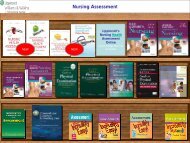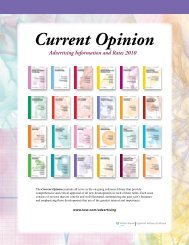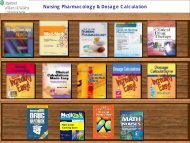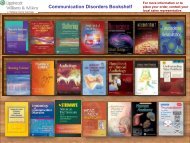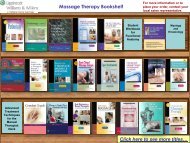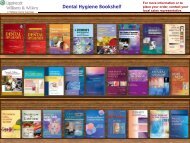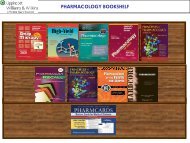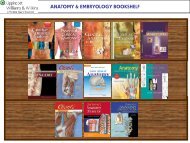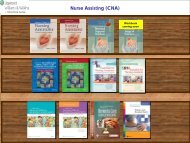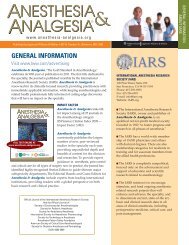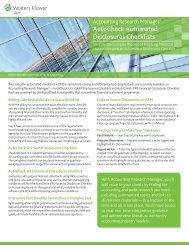Psychiatric â Mental Health Nursing - Lippincott Williams & Wilkins
Psychiatric â Mental Health Nursing - Lippincott Williams & Wilkins
Psychiatric â Mental Health Nursing - Lippincott Williams & Wilkins
You also want an ePaper? Increase the reach of your titles
YUMPU automatically turns print PDFs into web optimized ePapers that Google loves.
<strong>Psychiatric</strong> – <strong>Mental</strong> <strong>Health</strong> <strong>Nursing</strong>
Basic Concepts of <strong>Psychiatric</strong>-<strong>Mental</strong> <strong>Health</strong> <strong>Nursing</strong>, 8eLouise Rebraca Shives, MSN, ARNP, CNSFebruary 2011/ Approx. 75 illus./624 pps./ 978-160547-887-6Click here to access thePointStudent Resources• Glossary DrugMonographs• Learning Objectives• Power Point Presentations• Guided Lecture Notes• Discussion Topics• Assignments• Case Studies• Answers to Chapter-EndReview Questions• Journal Articles• Pre-Lecture Quizzes• Student Review (NCLEXstyle)• Questions Test• Generator• Movie Viewing GuidesFeatures:• Chapter Opening Quote• Learning Objectives• Key TermsWithin Chapter Features• Numbered Box• Numbered Table• Numbered Figure• Supporting Evidence for Practice• Clinical Example Box <strong>Nursing</strong> Plan of Care• Self-Awareness PromptEnd-of-chapter features• Key Concepts• Chapter Worksheet (includes 3 sections: Critical Thinking Questions, Reflection,and NCLEX-Style Questions)• Selected References Suggested Readings--Content is organized in a progressive manner:• Unit I begins with general information about psychiatric-mental health nursing• Unit II addresses special psychosocial issues Unit III addresses components of thenurse-client relationship
<strong>Psychiatric</strong>-<strong>Mental</strong> <strong>Health</strong> <strong>Nursing</strong>, 5eSheila L. Videbeck PhD, RNFebruary 12, 2010/ 576 pp / Approx. 79 Illus./ 978-1-60547-861-6Click here to access thePointStudent Resource DVDSpanish-English Audio Glossary, DrugMonographs, <strong>Nursing</strong> ProfessionalRoles and Responsibilities by NitaJane Carrington,LearningObjectives,J ournal Articles, NCLEX-Style Chapter Review Questions,Clin Sim Case Studies—Caring forthe Client in an Acutely ManicPhase, Caring for the Client withMajor Depressive Disorder, Caringfor the Client with ParanoidSchizophrenia in the AcutelyPsychotic Phase, Movie ViewingGuides, Searchable eBook<strong>Lippincott</strong>’s Interactive Case Studiesin <strong>Psychiatric</strong>-<strong>Mental</strong> <strong>Health</strong> <strong>Nursing</strong>:Therapeutic Communication,Antidepressants, Dementia,Cognitive FunctionsInstructor Resource DVDSyllabi (6 week and 8 week),Strategies for Effective Teaching,Image Bank, Power PointPresentations, Guided LectureNotes, Discussion Topics (andanswers), Assignments (andanswers), Case StudiesFeatures:• The book is designed and written for shortened courses• Built-in Chapter Study Guides provide workbook-style questions (fill-in, short-answer, andNCLEX-style) for students to test their knowledge and understanding of each chapter.Answers are found at the back of the book.• Clinical Vignettes are provided for each major disorder discussed in the text to “paint apicture” for better understanding.• Self-Awareness features appear at the end of each chapter, and encourage students toreflect on themselves, their emotions, and their attitudes as a way to foster both personaland professional development• Drug Alerts highlight essential points about psychotropic drugs.• Cultural Considerations sections appear in each chapter, as a response to increasingdiversity.• Therapeutic Communication dialogues are set off with an icon, and give specific examplesof nurse-client interaction to promote therapeutic communication skills. Clear distinction ismade throughout between social communication and therapeutic communication.• Client/Family Education boxes provide information that helps strengthen students’ roles aseducators.• Symptoms and Interventions are highlighted for chapters in Units 3 and 4.• Sample <strong>Nursing</strong> Care Plans are provided for chapters in Units 3 and 4 to offer students realworldexamples of treatment plans..• DSM-IV-TR boxes• New Points to Consider summarize what the nurse should do in the clinical setting
Instructor Resources:• Full Text Online• Syllabi• Strategies for EffectiveTeaching• Learning Objectives• Image Bank• Journal Articles• Test Generator• PowerPoint Slides withImages• Guided Lecture Notes• Lesson Plans• Psychotropic DrugMonographs• Case studies with Answers• Discussion Topics withAnswers• Assignments with Answers• Pre-Lecture Quiz withAnswers• Movie Viewing Guides withAnswers• Answers to CheckpointQuestions• Answers to Think About ItIssues• Answers to Study Questions• WebCT & Blackboard-Ready Materials<strong>Psychiatric</strong>-<strong>Mental</strong> <strong>Health</strong> <strong>Nursing</strong>: Evidence-BasedConcepts, Skills, and Practices, 7eWanda K. Mohr, PhD, RN, FAAN2008/ 912 pp./ 433 illus./ 978-0-7817-9097-0Click here to access thePointFeatures:• New! 25 Evidence-based Practice Spotlights summarize validated studies and findings andset forth the implications for nursing practice• New! Evidence-based Practice Summary tables compare and contrast the level ofevidence supporting various interventions• New! 12 new Case-in-Point studies take students through the nursing process steps formanaging various client/family scenarios• New! Over 30 Case Vignettes with accompanying Reflection and Critical Thinking Questionsgive students the chance to consider how they would apply their knowledge in dealingwith realistic client scenarios• New! 10 Understanding Biologic Foundations combine text and illustrations to build anunderstanding of core biologic processes, neuroanatomy, neurotransmission, andpathophysiology• New! Cultural Spotlight boxes in several chapters help students understand and be sensitiveto their clients' cultural environment• New! <strong>Health</strong>y People 2010 boxes summarize key objectives associated with particularchapters, promoting health and today's community-based care settings• New! New illustrations and photos help convey crucial points and assist visual learners inunderstanding symptoms, interventions, biologic mechanisms, and the characteristics andneeds of distinct clients• New! New Unit III, The Nurse-Client Relationship, includes two new chapters that helpstudents understand their role as caregivers: Chapter 8, <strong>Nursing</strong> Values, Attitudes, and Self-Awareness, and Chapter 10, The Interview and Assessment Process• New! New Unit V, Settings for Care, contains a new chapter on inpatient care settings aswell as fully revised chapters with the latest information on community/home and forensicsettings• New! New Unit VII, <strong>Psychiatric</strong> Emergencies, examines situations that require directed, acuteintervention such as anger, aggression, violence, and abuse, including a new chapter onSuicide and Suicidal Behavior
<strong>Lippincott</strong>’s Handbook for <strong>Psychiatric</strong> <strong>Nursing</strong> and CarePlanningSpringhouseJanuary 2009/ 640 pp./ 978-1-58255-730-4Features:• Sized for portability, this user-friendly handbook is spiral bound with a uniquefour-color design that makes it easy to access in any setting• Consistent presentation within and across sections facilitates studentunderstanding and allows for easy navigation• Contains 34 commonly used assessment• 84 individual drug monographs provide comprehensive drug information in aneasy to understand format• 28 care plans integrate NANDA, NIC, and NOC labels, enabling students tobecome familiar with the language of nursing• Coverage of Treatments prepares students for using the correct approacheswith patients in a clinical setting
<strong>Psychiatric</strong> <strong>Nursing</strong>: Contemporary Practice, 4eMary Ann Boyd, RN, PhD, DNSSeptember 2007/Approx. 37 illus./976 pps./978-0-7817-9169-4Features:Click here to access thePointStudent ResourcesNCLEX alternate-item formattutorialNCLEX style chapter reviewquestionsSpanish-English audioglossaryClinical SimulationsPsychotropic drugmonographsMovie viewing guides38 Journal ArticlesFull Text OnlineInstructor's ResourcesPowerPoint slides with imagesImage bank (JPG and PDF);Test Generator)NCLEX-styletest questionsAnswers to movie-viewingguide questions.SyllabiStrategies for effectiveteachingLearning ObjectivesGuided Lecture NotesDiscussion Topics withAnswersAssignments withAnswersPre Lecture QuizLesson Plans• NEW Unit (4 entire chapters, Unit 4) on on <strong>Mental</strong> <strong>Health</strong> Promotion with up-to-date evidence on stressmanagement, adult mental health promotion, and suicide. In addition, three additional chapters (16,28, and 31) address <strong>Mental</strong> <strong>Health</strong> Promotion across the lifespan within the chapters.• NEW Separate units (6 and 7)on the child/adolescent and the elderly help students provideappropriate care across the life span. This is an approach unique to Boyd.NEW Ancillaries (seedescription below)• NEW chapter on <strong>Nursing</strong> Care of the Patient in Forensic Settings• Newly revised Sleep Disorders chapter, previously a Web-only feature, is restored to the text• NEW <strong>Nursing</strong> Diagnosis Concept Maps in selected disorder chapters provide a roadmap tounderstanding• NEW Reflective boxes for critical thinking challenge students to examine key issues affecting dailypractice• Emergency nursing alerts identify potential crises and define the nurse's role and responsibilities in theirmanagement.• Emphasis on evidence-based practice shows how the latest research supports key nursing decisions.• Family focus includes a separate chapter on family assessment and integrates critical family contentthroughout each chapter.• Emphasis on psychopharmacologic content throughout the text emphasizes management of sideeffects and client/family education.• Interdisciplinary Treatment Plans and <strong>Nursing</strong> Care Plans show students how to use both for the samepatient.• Fame and Fortune boxes describe famous people and their experiences with mental health issues.• Helpful appendices provide fingertip access to commonly used diagnostic rating scales andquestionnaires.• Unique 3-ring biopsychosocial art provides a visual summary of etiologies, outcomes, and interventionsfor specific disorders--a great memory aid!• Drug Profiles describe current agents, their uses, and cautions.• Therapeutic Dialogues help build therapeutic relationships with clients.• Psychoeducation Checklists make sure students never miss a step.• Clinical Vignettes prepare students for real nursing challenges.
<strong>Lippincott</strong>’s Manual of <strong>Psychiatric</strong> <strong>Nursing</strong> Care Plans, 8eJudith M. Schultz, RN, MSSheila L. Videbeck, PhD, RN2008/ 464 pp./ 978-0-7817-6868-9Click here to access thePointInstructor & StudentResources:• 52 <strong>Nursing</strong> Care Plans• Psychotropic DrugMonographs• Customizable AssessmentTool• WebCT & Blackboard-Ready MaterialsFeatures:• Expanded content on evidence-based outcomes, increased coverage of thegrieving process, expanded psychopharmacology content, ANA standards ofcare, support group information, and screening tools• Accompanying CD-ROM and online resource offers printable nursing careplans, customizable assessment tool and psychotropic drug monographs• Comprehensive content, including a rationale for each and every interventionto help you understand the why you are performing the steps• Provides the latest information on NANDA nursing diagnoses and hospitaloutcomes• Expanded content on evidence-based outcomes for each care plan to ensureyou are using the best standards of practice
<strong>Lippincott</strong>’s Interactive Case Studies in <strong>Psychiatric</strong><strong>Mental</strong> <strong>Health</strong><strong>Lippincott</strong> <strong>Williams</strong> & <strong>Wilkins</strong>2008/ 978-1-60547-356-7Click here to access thePointFeatures:• Much of the product's content was created to be complementary to theseventh edition of Mohr: <strong>Psychiatric</strong> <strong>Mental</strong> <strong>Health</strong> <strong>Nursing</strong> but can be usedwith all LWW Psych MH nursing texts as well as a stand-alone resource or as asupplemental offering for students and instructors using any psychiatric nursingtext• Includes 12 modules containing two to three case studies each focus on theareas that psychiatric nursing instructors have identified as core content for thediscipline• Interactive exercises in each case combine multiple-choice, fill-in-the-blank,matching, sequencing, short-answer, and other types of questions to challengestudents and use a variety of approaches to enhance knowledge synthesis• The cases test students on key assessment findings, signs/symptoms, nursingpriorities, therapeutic communication, medication administration and followup,community transition, documentation, and other essential elements of carein this discipline• Instructors can assign modules as homework, class work, or self-study• Students can submit their answers to NCLEX-style practice questions at the endof each module to instructors as a quiz/homework/test feature
<strong>Psychiatric</strong> <strong>Nursing</strong> Made Incredibly Easy!, IncrediblyEasy! Series®Springhouse2003/ 576 pp./ 200 illus./ 978-1-58255-270-5Instructor Resources:•52 <strong>Nursing</strong> Care Plans•Psychotropic DrugMonographs•Customizable AssessmentTool•WebCT & Blackboard-Ready MaterialsFeatures:• Written in the award-winning Incredibly Easy style, this invaluable reference ispacked with the most up-to-date information on more than 70 psychiatricdisorders• Numerous icons provide the reader with tips on caring for psychiatric patientsfrom experts, the latest research, cultural considerations, and the latest news inpsychopharmacology. Memory joggers and quick quizzes reinforce learning• Easy-to-understand language brings complex concepts to light• Nurse Joy character offers tips and encourages the student as they progressthrough each topic• Collaborative management opportunities are introduced, identifyingappropriate involvement of other health care team members, so vital inclinical practice today• Continuum of care philosophy allows the students to apply knowledge to bothinpatient and outpatient settings• Numerous quick-scan tables, illustrations, and flow charts focus on keyinformation• Light humor and appropriate reviews enhance presentation of content• Liberal use of bullets keeps information concise and easy to find• An appendix of Web resources is included for further study



